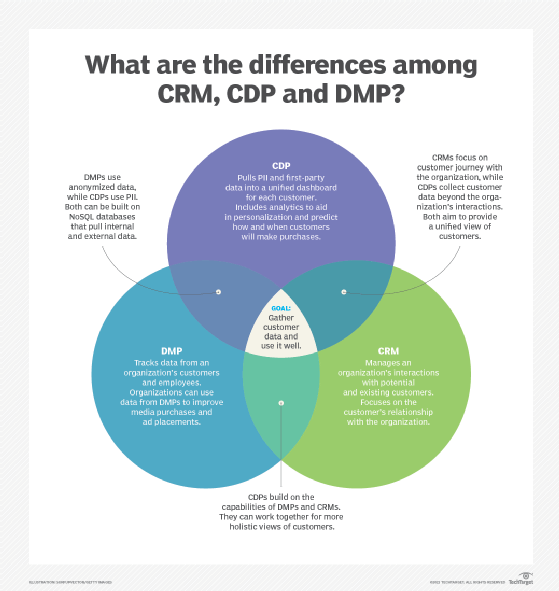
Getty Images/iStockphoto
CRM vs. CDP vs. DMP: What's the difference?
Sales and marketing terms are like alphabet soup, and the different acronyms can get confusing. Learn about the differences among three major platforms: CRM, CDP and DMP.
Acronyms for sales and marketing software are plentiful, and teams may struggle to remember what each one represents.
Customer relationship management (CRM) systems, customer data platforms (CDPs) and data management platforms (DMPs) all share a primary goal: to gather customer data from various sources as effectively as possible and store and use it in the best possible ways. While CRM systems, CDPs and DMPs are similar in how they collect and store data, they aren't the same.
Below, explore the key differences among the technologies.
CRM vs. CDP vs. DMP
All three platforms differ, but they also complement one another. CRM systems, CDPs and DMPs are distinct but harmonious components of one big machine that gathers customer information and puts it to the best possible use.
CRM vs. CDP
CRM systems and CDPs have opposite methods to efficiently gather and use customer data. CRM systems focus on the organization-customer relationship and facilitate the customer journey at each step, such as establishing brand loyalty and customer relationships. This system is the cornerstone of sales strategy and marketing campaign planning.
CDPs, on the other hand, strictly gather information. A CDP does a major task the CRM system doesn't: It retrieves offline data and tracks customers through social media and related sites beyond the organization's website. CDPs produce overall behavioral portraits of customers beyond their formal interactions with the organization. These platforms also collect personally identifiable information (PII), or data that can identify a specific person, such as names, email addresses, phone numbers, social media interactions, etc.
While sales representatives can use a CRM to view a customer's purchase record, they can't see customer engagement on social media posts. Only a CDP can show that information.
DMP vs. CDP
DMPs and CDPs are the most similar of the three platforms, as they can both be built on NoSQL database management systems to gather and display data from various sources. However, DMPs have a longer history than CDPs, which means newer technologies like machine learning and IoT affect how DMPs operate and force these platforms to evolve.
DMPs do not use PII like CDPs. Instead, they use anonymized data. CDPs also unify customer data across channels to eliminate redundancy.
CRM vs. DMP
CRMs and DMPs both predate CDPs, and CDPs build on the capabilities of CRMs and DMPs.
Sales and marketing teams need data on all potential and current customers to do their jobs effectively. This is beyond the scope of CRM systems, so DMPs fill the gap. Like CDPs, DMPs gather data on potential customer behavior culled from trackers on webpages. This data circles back into the CRM's processes and adds essential data about the population for marketers to segment and target.

What is a CRM?
CRM refers to software and data management tools that focus on the relationship between the organization and its customers, suppliers and service providers. CRM is more than a sales and marketing resource; it unifies the organization's view of customers across all business divisions, from supply chain management to HR.
A CRM system stores customer data from different channels, including all points of contact between an organization and its consumers. Service representatives can access information from interactions with the organization's website, phone, live chat, email, marketing materials and social media. With access to this data, service representatives can avoid asking customers to repeat themselves while on the phone, which improves efficiency and CX.
CRM vendors include Salesforce, Microsoft, SAP and Oracle. CRM systems come in three forms, which are the following:
- On-premises CRM. The organization is responsible for the administration, control, security and maintenance of these systems.
- Cloud-based CRM. These systems enable users to access information remotely.
- Open source CRM. These systems can enable data customization on social media channels, which improves social CRM practices.
What is a CDP?
CX novices may mistake a CDP for a CRM system, but the platforms differ. A CDP breaks down data silos and unifies customer data -- primarily first-party data -- from disparate sources into one platform to provide a single customer view. CDPs pull together customer demographic, behavioral and historical data from internal and external sources, including CSV files. Most CDPs use APIs to extract necessary data. CDPs then analyze this data in real time to predict which customers may buy certain products or services, as well as when and why they make those purchases.
Employees in any department, such as marketing, sales, customer support and finance, can access information in CDPs. With all customer data in one place, organizations can improve CX through personalization, product delivery and support. Organizations can also integrate CDPs with marketing automation platforms to better target their customers.
Vendors sell CDPs as packaged software, unlike a data warehouse that IT teams develop and manage. Companies that offer CDP products include Amperity, BlueConic and Salesforce.
What is a DMP?
A data management platform tracks and targets buyers like a CRM, but it also tracks everyone in the organization, whether they are customers or not. DMPs collect and store large amounts of structured and unstructured data, including audience data from online sources, such as CRM systems, web analytics, mobile channels and offline data, which organizations can use to support media purchases and ad placements. DMPs also gather business intelligence data about enterprise digital media offerings to plan campaigns.
DMPs collect, organize and segment first- and third-party data into different customer types, such as location, income, browsing behavior and past purchases. DMP vendors include Adform, Adobe and Oracle.
Editor's note: This article was originally written by Scott Robinson and expanded upon by Michaela Goss.
Michaela Goss is senior site editor for TechTarget's Customer Experience and Content Management sites. She joined TechTarget as a writer and editor in 2018.





